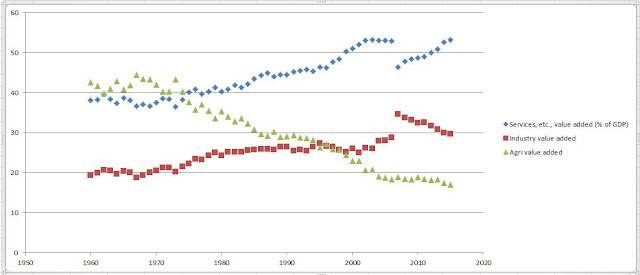Inequality: run without your legs
कही है रोशनी
तो कही है बस धुआ
कही है छत शीशे का
तो कही है आसमान खुला
And that's inequality.
Yes, it’s true that the disparity between rich and poor people is continuously increasing.
Recently Oxfam announced the data related to the wealth hold by richest people. According to Oxfam, own 58% of total wealth in India is owned by richest 1%. But why this disparity is increasing continuously? And does it really matter? Let’s have a discussion.
First figure shows that the GDP (current US$) (in billion), per capita GDP, government spending and tax revenue is increasing with similar trend. It means tax revenue and government spending (total) is increasing continuously and it's reflecting in the growth of GDP. As GINI coefficient for each year is not available, I am just using the share of top 1% richest people in GDP. We can draw a rough diagram of inequality.
Second diagram is showing that the income share of top 1% richest people is increasing after 1990. But is it serious? If there is economic growth, then it is obvious. Problems takes very serious and dangerous face when there is no growth in the income of certain people. It the income of certain group of people is stagnated, then the economic growth itself becomes a reason behind the increase in inequality.
Third figure clears all doubts. The value added in service sector is rapidly raising while it's rapidly decreasing in agricultural sector. As service sector is a labor intensive sector, the return on capital is very high. That's means owners (very few) of limited sectors are getting high returns while majority of people are getting very low return as they are highly dependent on agricultural sector. That means the growth which we have seen is not equitable.

Now last diagram is interesting. More complicated analysis of given figure is required. But two things are showing consistency i.e rate of government spending and rate of income share of top 1% people. They have clear opposite nature. When rate of government spending is high, the rate of income share of top 1% is very low and vice versa. Government spending can be a weapon to tackle the problem of inequality. As one sector has high growth and another has low, there must be balance. And it does matter. As there is disparity, we are seeing the outflow of worker from one sector to another. But the sector which has high returns is not able to absorb the excess labor supply. And that's why informal sector with problems related to health, crimes, unemployment are increasing. Market is there for efficient return but for fair and equitable return government should intervene. Rather than encouraging the sector which has already grown up for more economic growth, government has to focus more on the benefit transfer programs like skill, health, credit supply (specially for a sector which has low return)
(data sources - world bank, https://datahub.io/dataset/





.jpeg)
टिप्पण्या
टिप्पणी पोस्ट करा